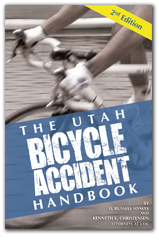 Utah Bicycle Laws
Utah Bicycle Laws
As bicycle use continues to increase, it is important to be aware of laws regarding bicycle use. This pertains to both motorists and bicyclists alike. Here is a summary of Utah bicycle laws that were gathered by the Utah Bicycle Coalition. Some of these laws you may already know, others may come as a surprise.
- It is illegal to operate a motor vehicle near a bicycle. The driver of an automobile may not knowingly drive within three feet of a moving bicycle.
- A peace officer may at any time stop a bicyclist to inspect and test the bicycle if the officer has reason to believe that it is unsafe or not equipped according to state laws.
- All bicyclists must have at least one hand on the steering handlebars at all times. A bicyclist may not carry a bundle, package, pack, or any other article that prohibits him/her from keeping both hands on the handle bars.
- A bicycle may never carry more persons than it is properly designed for.
- A bicyclist must never be attached to a moving motorized vehicle.
- A bicycle may not be equipped with a siren or a horn. Furthermore, a bicycle must be equipped with proper brakes. The brakes must be able to completely stop the bicycle within 25 feet from a speed of 25 miles per hour.
- When turning right, a bicyclist must extend his/her right hand and arm horizontally to signal to other motorists his/her intent to turn right.
- A bicyclist is not required to signal by hand or arm continuously if it is needed to maintain proper control of the bicycle.
- When turning left, a bicyclist must approach the term as close to the right curb as possible. The bicyclist must then ride across the intersection to the far corner of the intersection where he/she will stop as far from traffic as possible. Then, the bicyclist must yield to traffic and subsequently proceed in the new direction according to the traffic signals.
- Bicyclists must always yield the right-of-way to pedestrians and give an audible signal before overtaking a pedestrian.
- A person may park his/her bicycle on a sidewalk unless prohibited by a traffic-control device. The parked bicycle must not impede normal flow of pedestrian traffic on the sidewalk.
- When commuting at night, a bicycle must be equipped with a front headlight, a rear red deflector, side reflecting devices, all of which must be visible for 500 feet.
To learn more about bicycle safety, check out our free accident book with loads of information about bicycle accident injuries and bike safety.

